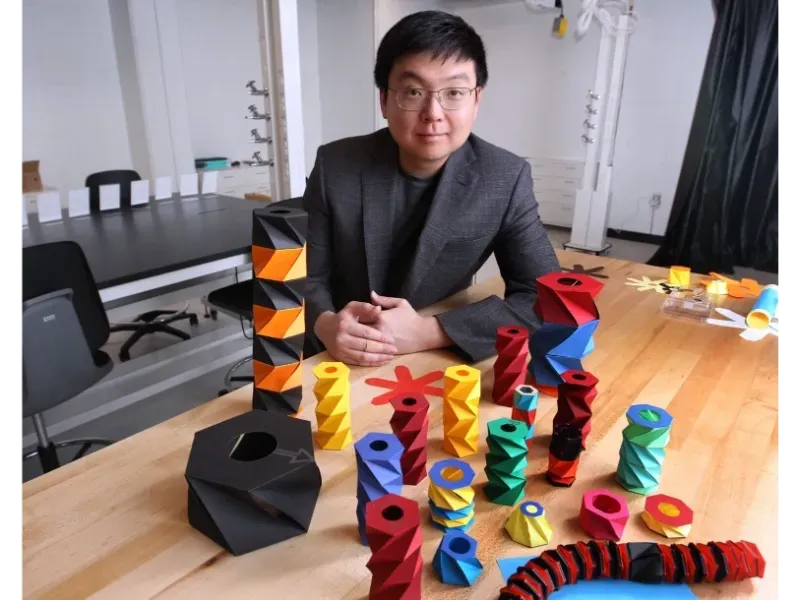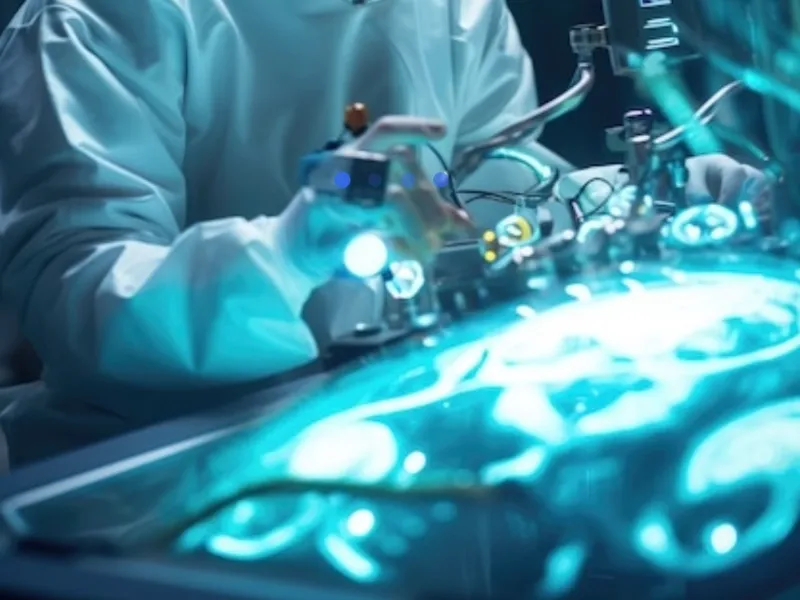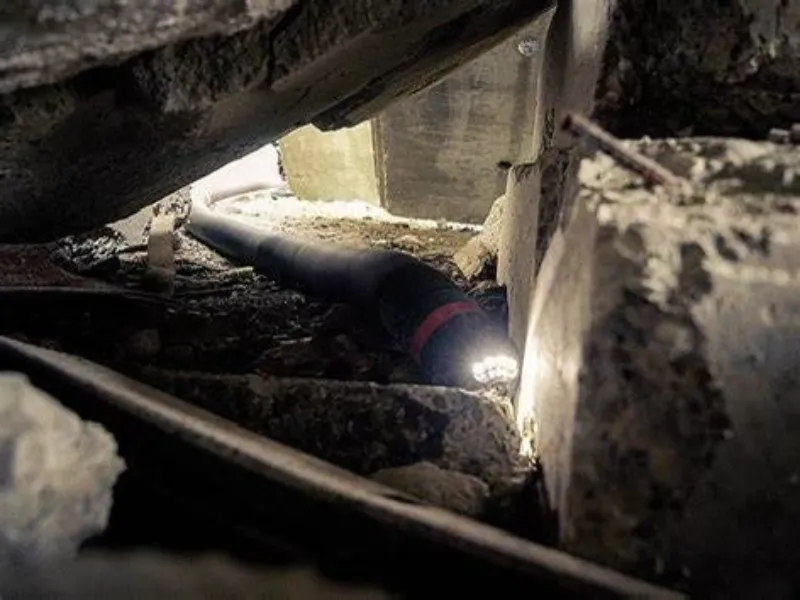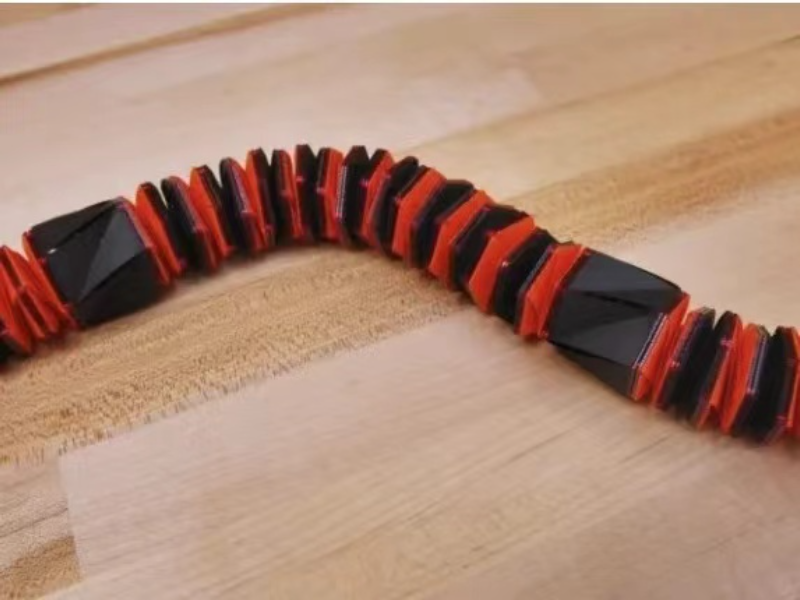- Engineers from Princeton and North Carolina State University have crafted a soft robot called the ‘Robotapillar’ to wiggle past the current limitations of traditional robotics when in tight or dangerous spaces.
- Robotapillars feature modular, cylindrical sections designed to operate as separate units or joined together to form an extended, adaptable structure that allows the robot to navigate complex mazes with flexibility and precision.
- The Robotapillar technology revolutionises various sectors including healthcare, agriculture, disaster response, environmental conservation, aerospace engineering, and construction, enhancing efficiency, safety, and sustainability through its flexible and minimally invasive capabilities.
OUR TAKE
Robotapillar is not just a small robot, it could revolutionise many industries, including healthcare, aerospace, construction, and the environment. Its innovative design and unique flexibility enhance the possibilities of our exploration of the world.
–Jinny Xu, BTW reporter
In a world increasingly dominated by technological wonders, a small but powerful innovation is making waves: the robotics pillar. And one flexible, caterpillar-like robot is making waves. It may seem inconspicuous at first glance, but its potential to revolutionise various fields is enormous. With its unique flexibility, the Robotapillar is capable of navigating tight spaces, carrying loads, and assembling into various configurations on command. It is crucial in a precise and delicate sports environment. From healthcare to agriculture, disaster response to environmental protection, aerospace engineering to construction innovation, Robotapillar is changing the world one step at a time. Let’s delve into it.
What is Robotapillar?
A new robot named Robotapillar has been developed using innovative modular cylindrical segments that can function independently or unite to form a longer unit, enhancing the robot’s mobility and steering capabilities. This adaptable robot can move forwards and backwards, collect cargo, and assemble into extended formations.
Also read: How does Atlas robot work?
Robotapillar is a new creation in the field of soft robotics. Unlike traditional robots made from rigid materials, Robotapillar is designed to mimic the flexibility and movement of a real caterpillar. Composed of soft, pliable materials and equipped with advanced actuators, it can crawl, bend, and twist through spaces that are impossible for conventional robots to navigate. Its design is inspired by nature, embodying the principles of biomimicry to achieve a new level of versatility and functionality.
“Each segment can be an individual unit, and they can communicate with each other and assemble on command,” said Tuo Zhao, a postdoctoral researcher at Princeton. “They can separate easily, and we use magnets to connect them.”
Each segment can be an individual unit, and they can communicate with each other and assemble on command.
Tuo Zhao, a postdoctoral researcher at Princeton.
Engineers at Princeton and North Carolina State University have combined ancient paper folding techniques and modern materials science to create a soft robot that can bend and twist through mazes with ease.

In a paper published on May 6 in the journal PNAS, researchers described how they created a robot using modular cylindrical segments. These segments can operate independently or join to form a longer unit, enhancing the robot’s ability to move and steer.
Also read: What is a humanoid robot?
The authors write in their article that the concept of modular soft robots can provide insight into future soft robots that can grow, repair, and develop new functions.
The robot’s modular body consists of a series of magnetically attached parts that can split apart and move collaboratively as a “swarm” if necessary while remaining linked in a caterpillar-like configuration for most applications.
Pop quiz
What unique capability do the segments of the Robotapillar have when detached?
A They can function as independent units
B They can fly
C They become immobile
D They dissolve
The correct answer is at the bottom of the article.
How does it change the world?
Medical marvels
Imagine a tiny, flexible robot gliding through your body, performing intricate surgeries or delivering medication with pinpoint accuracy. This is not science fiction; it’s the future of medicine with Robotapillar. Its ability to navigate the human body with minimal invasiveness could revolutionise surgical procedures. For example, it could enter through a small incision and traverse the gastrointestinal tract, performing biopsies, removing polyps, or delivering targeted drug therapies with minimal discomfort and faster recovery times.

Robotapillar could also play a role in diagnostics. Equipped with micro-cameras and sensors, it can explore areas like the intestines or lungs, providing real-time data to doctors and allowing for early detection of diseases such as cancer. This could lead to more accurate diagnoses and better patient outcomes.
Also read: 5 of the most convincing humanoid robot startups
Agricultural advancements
The agricultural sector is ripe for innovation, and Robotapillar is poised to be a game-changer. Traditional farming methods often struggle with issues like pest control and crop monitoring. Robotapillar can move through crops, identifying pests and diseases early, and applying treatments precisely where needed. This targeted approach reduces the need for widespread pesticide use, promoting healthier crops and a safer environment.
Moreover, Robotapillar can monitor soil conditions, ensuring optimal water and nutrient levels. By providing real-time data, farmers can make informed decisions, improving crop yields and sustainability. In a world where food security is a growing concern, these advancements could play a critical role in feeding a burgeoning global population.
Disaster response
Natural disasters strike without warning, leaving devastation in their wake. During such critical times, Robotapillar can be a lifesaver—literally. Its small size and flexible nature allow it to navigate through rubble and debris, reaching areas that are inaccessible to humans and larger robots. Equipped with sensors and cameras, it can locate survivors, assess their condition, and relay information to rescue teams.

Robotapillar can also deliver essential supplies like water, food, and medical kits to trapped individuals, sustaining them until help arrives. This swift and efficient response can significantly enhance rescue operations, saving lives in the process.
Environmental saviours
Our planet faces numerous environmental challenges, from polluted oceans to deforested lands. Robotapillar can help address these issues in ways that were previously unimaginable. Its ability to move through confined spaces makes it ideal for monitoring and cleaning up polluted areas. In marine environments, Robotapillar can dive into crevices and coral reefs, collecting data and removing debris without disturbing the delicate ecosystem.
On land, these robots can navigate through contaminated soils and areas affected by chemical spills, gathering samples and helping scientists assess the extent of pollution. This data is crucial for developing effective cleanup strategies and mitigating environmental damage.
Aerospace engineering
In the realm of aerospace engineering, Robotapillar’s unique abilities open up new possibilities. Inspecting and maintaining aircraft and spacecraft often involves navigating confined and hazardous spaces. Robotapillar can crawl through the narrowest of fuselage sections, performing inspections and identifying structural issues that are not easily accessible. It can also apply sealants, remove debris, and even assist in repairs, reducing downtime and enhancing safety.
For space exploration, Robotapillar could be a game-changer. Its adaptability allows it to function in microgravity environments, where traditional robots might struggle. It could explore tight spaces within spacecraft, assist in assembling modules on the International Space Station, or even conduct scientific research on other planets by crawling into caves and crevices that rovers cannot reach.

Construction innovation
In the construction industry, Robotapillar offers innovative solutions for building inspection and maintenance. High-rise buildings and intricate structures often pose challenges for safety and accessibility. Robotapillar can scale walls, navigate through ventilation systems, and inspect structural integrity in places that are dangerous or difficult for humans to reach. It can detect cracks, leaks, and other potential issues early, ensuring timely maintenance and preventing costly repairs.
Robotapillar’s flexibility also makes it ideal for tasks like wiring and plumbing in complex constructions. It can weave through tight spaces, laying cables or pipes with precision. This could revolutionise how we approach building designs, making the construction process more efficient and reducing the risk of human error.
A small robot with big potential
Paulino, the Margareta Engman Augustine Professor of Engineering, said. “This is a very promising technology with potential translation to robots that can grow, heal, and adapt on demand.”
This is a very promising technology with potential translation to robots that can grow, heal, and adapt on demand.
Paulino, the Margareta Engman Augustine Professor of Engineering
Robotapillar, although small in size, has the potential to make a huge impact on the world. It can revolutionise healthcare, and agriculture, aid in disaster response, contribute to environmental conservation, accelerate space exploration, and continuously innovate in construction. This flexible robot demonstrates how advanced technology can address some of the most pressing challenges of our time. As we explore and harness the capabilities of Robotapillar, we may find that this tiny robotic caterpillar holds the key to a brighter, more innovative future. Robotapillar is changing the world, one tiny crawl at a time.
The correct answer is A.

